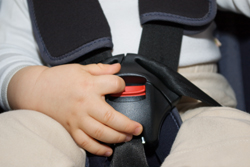Smart dummies may help save children's lives
Children are especially susceptible to injury in automobile accidents. In order to incorporate additional safety features into vehicles, it is necessary to collect experimental data using human replicas. In the context of the CHILD project, the Institut National de Recherche sur les Transports et leur Sécurité (INRETS) redesigned a family of human dummies for this purpose. The Q family of biofidelic dummies was targeted. A more realistic model of the human thoracic region was implemented by separating previously connected parts of the abdomen. In addition, the abdominal pressure sensors were split into right and left components to provide better feedback during both head-on and lateral collisions. Data from the sensors was used to derive Protection reference values (PRV) for all body segments. INRETS employed a methodology defining an Abdominal injury criterion (AIC), which is dependent on the rate of pressure change (V) and the pressure magnitude (P). Prototype and sled tests were performed during CHILD to examine issues related to durability, repeatability, deceleration and response to belt penetration. Both Q3 and Q6 dummies were evaluated. In a second phase, INRETS simulated accidents in an effort to gauge the suitability of the AIC approach. The initial results were positive and have encouraged the CHILD consortium to continue pursuing this line of research.



